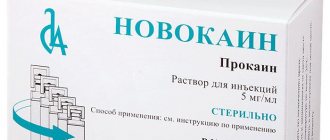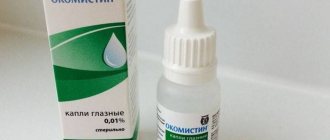Release form and composition
The drug is available in the form of eye drops: a transparent liquid with a slightly viscous structure, colorless or almost colorless (0.4 ml in polyethylene or polypropylene tube-droppers: 5 tube-droppers in a bag, in a cardboard pack of 2, 4, 6, 12 or 18 bags; 10 dropper tubes per bag, 1, 2, 3, 6 or 9 bags in a cardboard pack; 10, 20, 30, 60 or 90 dropper tubes in a cardboard pack; 5, 7 or 10 ml per plastic bottles equipped with a drip dispenser, 1 bottle in a cardboard pack; each pack also contains instructions for using Dorzolan solo).
1 ml drops contain:
- active ingredient: dorzolamide hydrochloride – 22.26 mg, which in terms of dorzolamide is 20 mg;
- auxiliary components: mannitol, sodium citrate dihydrate, 1M sodium hydroxide solution, sodium hyaluronate, water for injection.
Instructions for use
Before you start using eye drops, you need to carefully read the instructions.
It is not recommended to make adjustments to the dose or frequency of administration of the solution unless the attending physician suggests a different regimen.
The medicine Azopt is administered twice a day , 1 drop.
- Before use, shake the bottle so that the concentration of the contents is the same.
- Use the fingers of your free hand to pull down the lower eyelid. The dropper of the bottle is directed to the outer corner of the organ of vision.
- After administering the solution, do not close your eyes so that your eyelids do not displace the drug. It is enough to make several circles with the pupils, so the composition will be distributed evenly throughout the mucous membrane.
To prevent infection of the eye, it is recommended to thoroughly wash your hands before the procedure, and at the time of administering the solution, avoid contact of the tip of the dropper with the mucous membrane.
Pharmacological properties
Pharmacodynamics
Dorzolan solo is an antiglaucoma drug in the form of eye drops, the active substance of which is a carbonic anhydrase II inhibitor - dorzolamide hydrochloride.
The mechanism of action of the solution is due to the inhibition of carbonic anhydrase in the ciliary body of the eyeball, causing a decrease in the production of intraocular fluid. It is assumed that fluid removal occurs due to a slowdown in the synthesis of bicarbonate ions and their subsequent reduction to sodium. This helps lower intraocular pressure.
Pharmacokinetics
Long-term use of dorzolamide hydrochloride, as a result of selective binding to carbonic anhydrase II (KA-II), leads to its selective accumulation in erythrocytes, while the plasma concentration of free dorzolamide remains very low.
Plasma protein binding is about 33%.
Dorzolamide is metabolized to form a single metabolite, N-desethyl-dorzolamide, which accumulates in erythrocytes and binds mainly to carbonic anhydrase I (KA-I). The inhibitory activity of the metabolite against the enzyme KA-II and KA-I is lower than that of dorzolamide.
Elimination of dorzolamide and its metabolite occurs through the kidneys.
The half-life of the active substance is about 4 months. After discontinuation of the drug, uneven leaching of dorzolamide from red blood cells is observed. The initial phase is characterized by very intense elimination and a rapid, significant decrease in its concentration, then the rate of elimination becomes significantly lower.
Comparison of safety of Azopt and Dorzopt
The safety of a drug includes many factors.
At the same time, in Azopt it is quite similar to Dorzopt. It is important where the drug is metabolized: drugs are excreted from the body either unchanged or in the form of products of their biochemical transformations. Metabolism occurs spontaneously, but most often involves major organs such as the liver, kidneys, lungs, skin, brain and others. When assessing metabolism in Azopt, as well as in Dorzopt, we look at which organ is the metabolizing organ and how critical the effect on it is.
The risk-benefit ratio is when the prescription of a drug is undesirable, but justified under certain conditions and circumstances, with the obligatory observance of caution in use. At the same time, Azopt does not have any risks when used, just like Dorzopt.
Also, when calculating safety, it is taken into account whether only allergic reactions occur or possible dysfunction of the main organs. In other matters, as well as the reversibility of the consequences of using Azopt and Dorzopt.
Dorzolan solo, instructions for use: method and dosage
Dorzolan solo eye drops are intended for topical use by injection into the conjunctival sac.
To carry out the procedure, you need to place a dropper tube or a bottle dropper dispenser above the eye and pull down the lower eyelid with the index finger of one hand. At the same time, with your other hand, lightly pressing on the tube or bottle, drip the solution into the conjunctival sac.
When using tube droppers, keep in mind that their contents are designed for only one procedure in both eyes. Therefore, having separated one dropper tube, it is placed in a vertical position so that the solution moves to the lower part. To open the dropper tube, you need to turn the valve with a rotating motion and separate it. After the procedure, the dropper tube is discarded, even if there is a solution in it.
The bottle is opened by removing the safety ring. Carefully remove the cap and secure the bottle between the thumb and forefinger. Immediately before instilling the drug into the eye, it is recommended to pump the dispenser by pressing the top of the bottle with your index finger until the first drop of solution appears. Turning the bottle over with the dispenser down, it is placed above the eye and instilled. After use, the bottle should be tightly capped.
Do not allow the dropper and the tip of the open bottle to come into contact with any surfaces.
The contents of an opened bottle can be used throughout the expiration date.
If damage is detected during a visual inspection of the dropper tube or bottle, the drug is not suitable for use.
Recommended dosage: 1 drop 3 times a day (morning, afternoon and evening) into the affected eye or both eyes.
When switching from another antiglaucoma drug, the use of Dorzolan solo should be started the next day after discontinuation of the previous drug.
When using several local ophthalmic agents simultaneously, the interval between their use should be at least 10 minutes.
Comparison of addiction between Azopt and Dorzopt
Like safety, addiction also involves many factors that must be considered when evaluating a drug.
Thus, the totality of the values of such parameters as “o syndrome” in Azopt is quite similar to the similar values in Dorzopt. Withdrawal syndrome is a pathological condition that occurs after the cessation of intake of addictive or dependent substances into the body. And resistance is understood as initial immunity to a drug; in this it differs from addiction, when immunity to a drug develops over a certain period of time. The presence of resistance can only be stated if an attempt has been made to increase the dose of the drug to the maximum possible. At the same time, in Azopt the meaning of the “syndrome” is quite small, however, the same as in Dorzopt.
Side effects
- from the organ of vision: very often – burning, pain in the eye; often - lacrimation, itching, blurred vision, superficial punctate keratitis, inflammation of the eyelids, conjunctivitis, irritation of the eyelid; uncommon – iridocyclitis; rarely - redness of the eyes, hyperkeratosis of the eyelids, corneal edema, pain, transient myopia (after discontinuation of Dorzolan solo disappears), decreased intraocular pressure; after surgery to restore the outflow of intraocular fluid - detachment of the choroidal membrane of the eye;
- from the nervous system: often – headache; rarely – paresthesia, dizziness;
- from the gastrointestinal tract: often – bitter taste in the mouth, nausea; rarely – dry mouth, pharyngitis;
- from the respiratory system, chest and mediastinum: rarely – nosebleeds;
- from the urinary tract: rarely - urolithiasis;
- dermatological reactions: rarely - contact dermatitis, toxic epidermal necrolysis, Stevens-Johnson syndrome;
- general disorders and local disorders: often – fatigue, asthenia; rarely - allergic reactions of local (from the eyelids) and systemic (itching, rash, urticaria, angioedema, difficulty breathing, bronchospasm) nature.
Comparison of the effectiveness of Dorzopt and Glauprost
Dorzopt is more effective than Glauprost - this means that the ability of the drug substance to provide the maximum possible effect is different.
For example, if the therapeutic effect of Dorzopt is more pronounced, then with Glauprost it is impossible to achieve this effect even in large doses.
Also, the speed of therapy is an indicator of the speed of therapeutic action; Dorzopt and Glauprost are also different, as is bioavailability - the amount of a drug substance reaching the place of its action in the body. The higher the bioavailability, the less it will be lost during absorption and use by the body.
special instructions
To prevent unwanted drug-drug interactions when prescribing Dorzolan solo, the doctor should be informed that the patient is taking all medications.
Impact on the ability to drive vehicles and complex mechanisms
During the period of using Dorzolan solo, it is recommended to refrain from driving vehicles, working with complex mechanisms and performing other potentially dangerous activities that require increased concentration and high speed of psychomotor reactions.
Comparison of side effects of Azopt and Dorzopt
Side effects or adverse events are any adverse medical event that occurs in a subject after administration of a drug.
Azopt's side effects are almost the same as Dorzopt's. They both have few side effects. This implies that the frequency of their occurrence is low, that is, the indicator of how many cases of an undesirable effect of treatment are possible and registered is low. The undesirable effect on the body, the strength of influence and the toxic effect of Azopt are similar to Dorzopt: how quickly the body recovers after taking it and whether it recovers at all.
Drug interactions
Special studies have not been conducted to study the interaction of Dorzolan solo with other drugs.
In clinical studies, the use of dorzolamide in the form of eye drops in combination with eye drops containing timolol or betaxolol and systemic drugs such as calcium channel blockers, diuretics, angiotensin-converting enzyme inhibitors, non-steroidal anti-inflammatory drugs (including acetylsalicylic acid), hormones (estrogen, insulin , levothyroxine sodium) did not cause negative interaction reactions.
It is assumed that the simultaneous use of high doses of acetylsalicylic acid may increase the toxicity of Dorzolan solo.
When Dorzolan solo is combined with carbonic anhydrase inhibitors for oral administration, a mutual enhancement of systemic effects is possible.
It should be borne in mind that while taking high doses of salicylates, the acid-base balance may be disrupted.
Comparison of the effectiveness of Azopt and Dorzopt
The effectiveness of Azopt is quite similar to Dorzopt - this means that the ability of the drug substance to provide the maximum possible effect is similar.
For example, if the therapeutic effect of Azopt is more pronounced, then using Dorzopt even in large doses will not achieve this effect.
Also, the speed of therapy - an indicator of the speed of therapeutic action - is approximately the same for Azopt and Dorzopt. And bioavailability, that is, the amount of a drug reaching its site of action in the body, is similar. The higher the bioavailability, the less it will be lost during absorption and use by the body.











